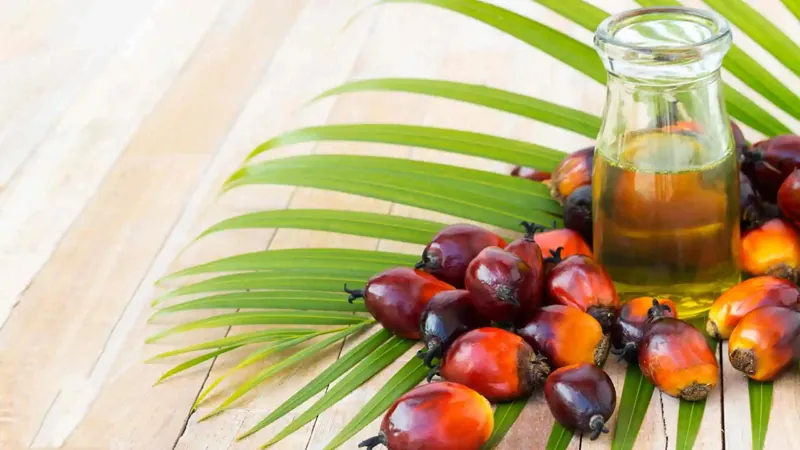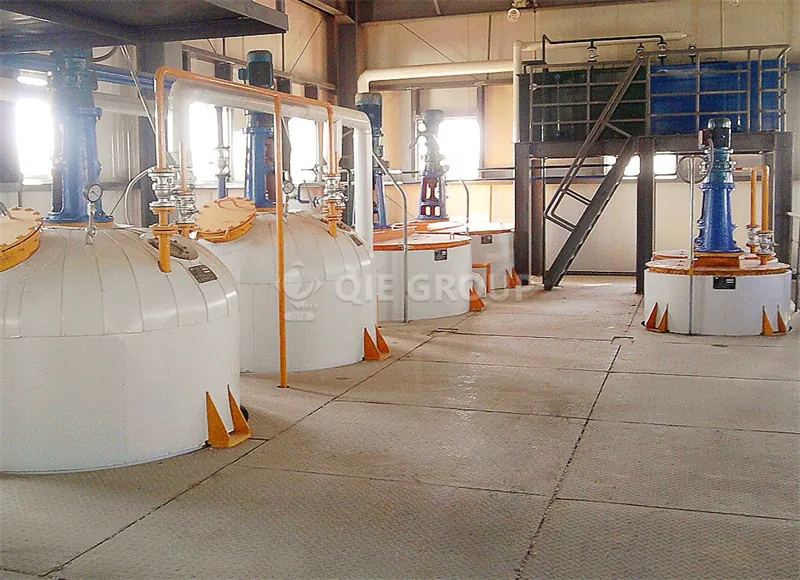

In the field of edible oil processing, palm oil is an important oil resource, and its refining process is crucial. Palm oil semi-continuous refining equipment is a key equipment specially designed for refining and pressing crude palm oil. It effectively removes various impurities in the oil through a series of fine process flows, so that the various components of palm oil strictly meet national standards, thereby significantly improving the quality and market value of palm oil. Palm oil semi-continuous refining equipment is mainly suitable for small and medium-sized palm oil refinery plant or palm oil production plants, with processing capacities of 5 tons/day, 10 tons/day, 15 tons/day, 20 tons/day, and 30 tons/day respectively.

Crude palm oil → degumming → deacidification → decolorization → deodorization → refined palm oil
Degumming
Degumming is the first step of the entire refining process, and its core purpose is to remove the peptized impurities in crude palm oil. The presence of these peptized impurities will affect the quality and stability of palm oil and must be removed. In actual operation, the staff will accurately add an appropriate amount of phosphoric acid solution to the crude oil and then stir it thoroughly. During the stirring process, the peptized impurities will gradually condense into agglomerates. After sedimentation separation, these impurities can be effectively removed, thus laying a good foundation for the subsequent refining steps.
Deacidification
The deacidification process of semi-continuous palm oil refining is divided into two parts: chemical deacidification and physical deacidification. Chemical deacidification is carried out in the alkali refining pot. The operator adds alkali solution to the palm oil, and the alkali solution reacts with the free fatty acids in the palm oil to neutralize and remove the free fatty acids. Physical deacidification is carried out in the upper part of the deodorization tower. By directly introducing steam into the deodorization tower, the free fatty acids are taken away from the palm oil by the principle of distillation. After deacidification is completed, water washing and drying steps are usually carried out. This step has a dual role. On the one hand, it can remove the colloid and soap stock remaining in the oil after degumming and deacidification to prevent these impurities from interfering with subsequent processes; on the other hand, it also makes full preparations for better decolorization operations to ensure the best decolorization effect.
Decolorization
The bleaching process mainly uses the powerful adsorption effect of white clay to remove the pigments in crude palm oil. It is worth mentioning that white clay can not only absorb pigments, but also absorb some other granular impurities, further improving the purity of palm oil. When performing the bleaching operation, in addition to the bleaching pot, a leaf filter is also required. The function of the leaf filter is to filter the waste white clay in the palm oil to ensure that the bleached palm oil is purer and more transparent.
Deodorization
Deodorization is a crucial step in the entire refining process, and its purpose is to remove the odor in crude palm oil, thereby improving the flavor, smoke point, stability and quality of palm oil. The deodorization equipment used in semi-continuous refining of palm oil is a deodorization tower, which has a unique design. The upper part is used for deacidification and the lower part is specifically used for deodorization. Good gas separation treatment is required before deodorization. This step effectively prevents the oil from oxidizing at high temperatures by extracting oxygen from the palm oil, thereby ensuring the smooth progress of the deodorization process and the stability of the palm oil quality. Subsequently, direct steam is passed into the deodorization tower to remove the odorous substances in the palm oil by utilizing the difference in volatility between the oil and the odorous substances.
After the deodorization process, high-quality refined palm oil can be obtained. At this time, the refined palm oil is transparent in color, and will not produce precipitation even if it is left for a long time. No smoke is generated during use. It fully meets national standards and can be sold directly on the market to meet consumers' demand for high-quality palm oil.

1. The refining effect is good, and the process flow can be adjusted according to the quality of oil products and the requirements of the final finished oil.
2. Reasonable operation and advanced equipment reduce fuel consumption.
3. In the bleaching stage, the oil and clay are mixed under vacuum conditions. This avoids the influence of air and thus reduces the consumption of clay.
4. Clay quantitative adding machine can add clay accurately.
5. The entire deodorization process is carried out under vacuum conditions. Vacuum can prevent oil oxidation and improve oil quality.
6. Use steam stripping and distillation processes to maintain the taste and stability of the final oil.
7. It has a wide range of uses and can also be used to refine other edible oils, such as peanut oil, soybean oil, sunflower oil, etc.
QIE GROUP has been deeply involved in the palm oil refining equipment processing and manufacturing industry for 40 years and has accumulated rich experience and technical strength. The palm oil semi-continuous refining equipment we provide is directly supplied by the factory, which guarantees the quality of the equipment from the source. These equipments have undergone strict quality inspections and have a long service life, which can provide strong support for the long-term and stable production of enterprises.
If you need palm oil semi-continuous refining equipment, or need a complete set of palm oil production line equipment, please feel free to contact QIE GROUP.










